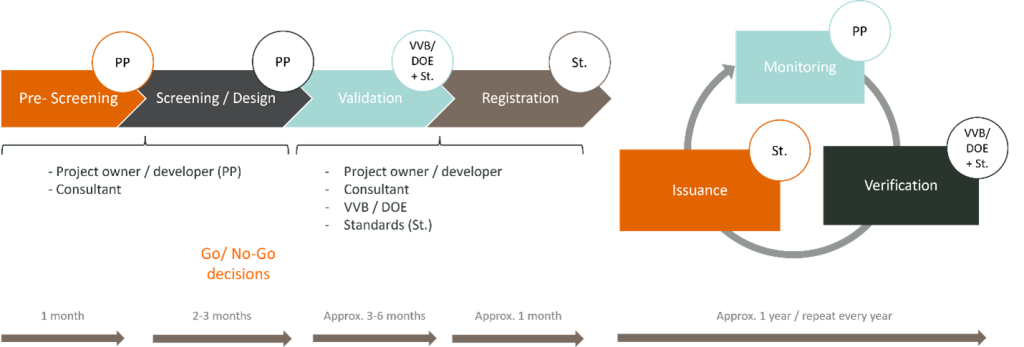Figure 2 provides an outline of the project cycle for the development, registration, and issuance of credits from a carbon project. The average duration for the project design, validation and registration is around one year and that of the verification and issuance of credits is around a further year. (Links to Project Cycle Process – GS, VCS, CDM).

Pre-screening and Feasibility
Most projects start their implementation with a Project Idea Note (PIN). It is initiated by the project developer, in many cases with the support of a consultant. The PIN is not binding but is often used as a project pitch with the potential buyers and investors and consists of indicative information on 1) Project type, size, and location; 2) Anticipated total amount of emission reduction; 3) Crediting period; 4) Expected price per tCO2; 5) Financial structuring; 6) Project’s other socioeconomic or environmental benefits.
Project Design Document, Validation and Registration
A Project Design Document (PDD) is prepared once the initial PIN indicates feasibility of a project. The PDD is prepared following specialised formats as per the standards selected (PDD templates CDM, GS, VCS). The PDD contains the detailed argument for the ‘additionality’ of the project calculation of the project period and baseline emissions as per the specified methodology (using guidelines and design tools accompanying the methodology), justifications for the assumptions and parameter values used in the calculations, and specification of the monitoring protocols that will be followed to verify and report the emission reductions.
The PDD is developed together with the stakeholder consultation as per the standard’s guidelines. It is conducted at the field level directly with local stakeholders as well as with the national level stakeholders, to inform and discuss the process, outcomes, costs, and benefits of the project. The processes involved, the questions and concerns raised, and the redress mechanism are compiled in the form of a Stakeholder Consultation Report (Templates GS – with CDM and VCS, it is part of the PDD) and submitted along with the PDD. For CDM, the project developers also need to submit a letter of authorisation from the respective Designated National Authority (DNA). A DNA is the organization granted responsibility to authorise and approve participation in the CDM as per the UNFCCC process which are usually the respective Ministry of Environment in the country where the project is located.
Validation involves an audit of the proposed project based on the submitted PDD, Stakeholder Consultation Report and the other required documents by third-party auditors. These auditors are known as Designated Operational Entities (DOEs) under the CDM mechanism and Validation and Verification Bodies (VVBs) in the VCM. A successful validation of the project results in its registration which then leads to publication of the PDD, Stakeholder Consultation Report and the other related documents in the respective registries.
Monitoring, Verification, and Issuance
Once the project is registered, periodic verification for the issuance of credits for the project is carried out at least every two years. Projects can choose to do this every year depending on the project progress i.e., the number of project technologies installed and thus the potential credits generated which is weighed against the monitoring cost, contractual agreements, and requirements of the respective standards. After the completion of the specific milestones (annual progress), the project developer is required to conduct a project monitoring following the specific procedures predefined in the PDD. The monitoring report is then submitted to the standard/mechanism with a request for verification.
Verification involves an audit of the project based on the submitted monitoring report. A successful verification results in the issuance of credits to the project registry maintained with the respective standard/mechanism. The project developer can then use (transfer or retire) the issued credits.
Validation and verification are carried out by accredited independent auditors (List for VCS, GS and CDM). These auditors are often listed with multiple standards and mechanisms. It is also possible to carry out the validation and verification together, to reduce costs and time required, depending on the timeline of the project start date and the date of validation and verification request. Projects are credited for a period of 5 years after which the project has to go through validation with a revised PDD to check that assumptions and parameters are still relevant.
Program of Activities
A Program of Activity or PoA is developed in a similar way as an individual project but once a PoA framework is registered, an unlimited number of smaller project activities can be added without undergoing the detailed project registration process mentioned above. PoAs are therefore more suitable for activities implemented regularly and over time. Compared to independent projects, PoAs have multiple benefits, particularly for less developed countries. They lower project costs as these can be managed by a single coordinating entity and monitoring can be carried out based on a collective sampling approach. PoAs improve access to carbon revenues for smaller projects which otherwise would not be viable as stand-alone projects. This handbook prepared by Climate Focus provides details on the application of PoAs in the CDM and the voluntary carbon standards.
……………………………
Click here to go back to the carbon financing main menu.